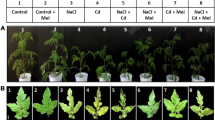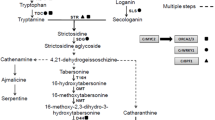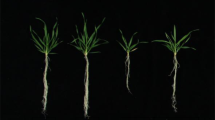Abstract
Key message
Melatonin is an early player in chromium stress response in canola plants; it promotes ROS scavenging and chlorophyll stability, modulates PSII stability and regulates feedback inhibition of photosynthesis conferring chromium tolerance.
Abstract
The development of heavy metals, especially chromium (Cr)-tolerant cultivars is mainly constrained due to poor knowledge of the mechanism behind Cr stress tolerance. In the present study, two Brassica napus contrasting cultivars Ac-Excel and DGL were studied for Cr stress tolerance by using chlorophyll a fluorescence technique and biochemical attributes with and without melatonin (MT) treatments. Cr stress significantly reduced the PSII and PSI efficiency, biomass accumulation, proline content and antioxidant enzymes in both the cultivars. The application of MT minimized the oxidative stress, as revealed via a lower level of reactive oxygen species (ROS) synthesis (H2O2 and OH−). Enhanced enzymatic activities of important antioxidants (SOD, APX, CAT, POD), proline and total soluble protein contents under MT application play an effective role in the regulation of multiple transcriptional pathways involved in oxidative stress responses. Higher NPQ and Y(NPQ) observed in Cr stress tolerant cv Ac-Excel, indicating that the MT-treated tolerant cultivar had better ability to protect PSII under Cr stress by increasing heat dissipation as photo-protective component of NPQ. Reduced PSI efficiency along with increased donor end limitation of PSI in both canola cultivars further confirmed the lower PSII activity and electron transport from PSII. The Cr content was higher in cv. DGL as compared to (that in Ac-Excel). The application of MT significantly decreased the Cr content in leaves of both cultivars. Overall, MT-induced Cr stress tolerance in canola cultivars can be related to improved PSII activity, Y(NPQ), and antioxidant potential and these physiological attributes can effectively be used to select cultivars for Cr stress tolerance.









Similar content being viewed by others
Abbreviations
- ANOVA:
-
Analysis of variance
- APX:
-
Ascorbate peroxidase
- CAT:
-
Catalase
- DW:
-
Dry weight
- EDTA:
-
Ethylenediaminetetraacetic acid
- Fv/Fm:
-
Primary photochemistry of PSII
- FW:
-
Fresh weight
- H2O2 :
-
Hydrogen peroxide
- MDA:
-
Malonaldehyde
- Na2HPO4 :
-
Disodium phosphate
- NBT:
-
Nitro blue tetrazolium chloride
- PBS:
-
Phosphate buffer solution
- POD:
-
Peroxidase
- PSI, PSII:
-
Photosystem I, photosystem II
- ROS:
-
Reactive oxygen species
- RWC:
-
Relative water content
- SOD:
-
Superoxide dismutase
- TBA:
-
Thiobarbituric acid
- TCA:
-
Trichloroacetic acid
- TW:
-
Turgid weight
- MT:
-
Melatonin
- Cr:
-
Chromium
- ETR:
-
Electron transport rate
- PI:
-
Performance index
- KI:
-
Potassium iodide
- QA:
-
Quinone A
- ASA:
-
Ascorbic acid
- Fo:
-
Minimum fluorescence
- Fm:
-
Maximum fluorescence
- Mo:
-
Maximum rate of accumulation of closed reaction centers
- N :
-
Maximum turnovers of QA reduction until Fm was reached
- Fv/Fm:
-
Maximum quantum yield of PSII
- Fv/Fo:
-
Efficiency of electron donation to PSII; absorption per reaction center at PSII/ratio of active reaction centers in PSII (Clark et al. 2000)
- TRo/RC:
-
Trapped energy flux per reaction center
- ETo/RC:
-
Electron transport flux per reaction center
- DIo/RC:
-
Dissipation energy flux per reaction center
- PIABS :
-
Performance index on absorption basis
- NPQ:
-
Non-photochemical quenching
- Y(NPQ):
-
Protective photochemical quenching
- Y(I):
-
Quantum yield of PS(I)
- Y(II):
-
Quantum yield of PS(II)
- Y(ND):
-
Donor site limitation of PS(I)
References
Aebi H (1984) Catalase in vitro. In: Methods in enzymology. Elsevier, pp 121–126.
Ahmad R, Ali S, Abid M, Rizwan M, Ali B, Tanveer A, Ahmad I, Azam M, Ghani MA (2020) Glycinebetaine alleviates the chromium toxicity in Brassica oleracea L. by suppressing oxidative stress and modulating the plant morphology and photosynthetic attributes. Environ Sci Pollut Res 27(1):1101–1111
Altaf MA, Shahid R, Ren MX, Mora-Poblete F, Arnao MB, Naz S, Anwar M, Altaf MM, Shahid S, Shakoor A, Sohail H, Ahmar S, Kamran M, Chen JT (2021) Phytomelatonin: an overview of the importance and mediating functions of melatonin against environmental stresses. Physiol Plant 172:820–846
Ayyaz A, Amir M, Umer S, Iqbal M, Bano H, Gul HS, Noor Y, Javed M, Athar HR, Zafar ZU (2020a) Melatonin induced changes in photosynthetic efficiency as probed by OJIP associated with improved chromium stress tolerance in canola (Brassica napus L.). Heliyon 6(7):2020.e04364
Ayyaz A, Farooq MA, Kanwal A, Aslam M, Iqbal M, Manzoor A, Khalid A, Umer S, Bano H, Rasool B, Athar HR, Zafar ZU (2020b) Differential responses of exogenous melatonin on growth, photosynthesis and antioxidant defence system in two Brassica napus L. cultivars under chromium stress. IJAEB 5(2):397–411
Ayyaz A, Noor Y, Bano H, Ghani MA, Javed M, Iqbal M, Zafar ZU, Farooq MA (2021) Effects of exogenously applied melatonin on growth, photosynthesis, ion accumulation and antioxidant capacity of canola (Brassica napus L.) under chromium stress. Pak J Bot 53:5
Banerjee A, Roychoudhury A (2020) Plant Responses to environmental nickel toxicity. In: Aftab T, Hakeem KR (eds) Plant micronutrients: deficiency and toxicity management. Springer, Cham, pp 101–111
Banerjee A, Roychoudhury A (2021) Maghemite nano-fertilization promotes fluoride tolerance in rice by restoring grain yield and modulating the ionome and physiome. Ecotoxicol Environ Saf 215:112055
Bano H, Athar H-U-R, Zafar ZU, Ogbaga CC, Ashraf M (2021) Peroxidase activity and operation of photo-protective component of NPQ play key roles in drought tolerance of mung bean [Vigna radiata (L.) Wilcziek]. Physiol Plant 172(2):1–12
Bates L, Wadern R, Teare I (1973) Rapid estimation of free proline for water stress determination. Plant Soil 39(1):205–207
Bradford MM (1976) A rapid and sensitive method for the quantitation of microgram quantities of protein utilizing the principle of protein-dye binding. Anal Biochem 72(1–2):248–254
Bücker-Neto L, Paiva ALS, Machado RD, Arenhart RA, Margis-Pinheiro M (2017) Interactions between plant hormones and heavy metals responses. Genet Mol Biol 40(1):373–386
Chaturvedi R, Talwar L, Malik G, Paul MS (2020) Heavy metal-induced toxicity responses in plants: an overview from physicochemical to molecular level. Cell Mol Phytotox Heavy Metals. https://doi.org/10.1007/978-3-030-45975-8_5
Chen Z, Song S, Wen Y, Zou Y, Liu H (2016) Toxicity of Cu (II) to the green alga Chlorella vulgaris: a perspective of photosynthesis and oxidant stress. Environ Sci Pollut Res 23(18):17910–17918
Chen YE, Mao JJ, Sun LQ, Huang B, Ding CB, Gu Y, Liao JQ, Hu C, Zhang ZW, Yuan S (2018) Exogenous melatonin enhances salt stress tolerance in maize seedlings by improving antioxidant and photosynthetic capacity. Physiol Plant 164(3):349–363
Ding F, Liu B, Zhang S (2017) Exogenous melatonin ameliorates cold-induced damage in tomato plants. Sci Hortic 219:264–271
Farooq MA, Ali S, Hameed A, Ishaque W, Mahmood K, Iqbal Z (2013) Alleviation of cadmium toxicity by silicon is related to elevated photosynthesis, antioxidant enzymes; suppressed cadmium uptake and oxidative stress in cotton. Ecotoxicol Environ Saf 96:242–249
Farooq MA, Gill RA, Islam F, Ali B, Liu H, Xu J, He S, Zhou W (2016) Methyl jasmonate regulates antioxidant defense and suppresses arsenic uptake in Brassica napus L. Front Plant Sci 7:468–468
Farouk S, Al-Amri SM (2019) Exogenous melatonin-mediated modulation of arsenic tolerance with improved accretion of secondary metabolite production, activating antioxidant capacity and improved chloroplast ultrastructure in rosemary herb. Ecotoxicol Environ Saf 180:333–347
Ghori NH, Ghori T, Hayat MQ, Imadi SR, Gul A, Altay V, Ozturk M (2019) Heavy metal stress and responses in plants. Int J Environ Sci Technol 16:1807–1828
Gill RA, Hu XQ, Ali B, Yang C, Shou JY, Wu Y, Zhou WJ (2014) Genotypic variation of the responses to chromium toxicity in four oilseed rape cultivars. Biol Plant 58:539–550
Gill RA, Zang L, Ali B, Farooq MA, Cui P, Yang S, Ali S, Zhou W (2015) Chromium-induced physio-chemical and ultrastructural changes in four cultivars of Brassica napus L. Chemosphere 120:154–164
Goussi R, Manaa A, Derbali W, Cantamessa S, Abdelly C, Barbato R (2018) Comparative analysis of salt stress, duration and intensity, on the chloroplast ultrastructure and photosynthetic apparatus in Thellungiella salsuginea. J Photochem Photobiol B Biol 183:275–287
Hanelt D (2018) Photosynthesis assessed by chlorophyll fluorescence. In: Bioassays. Elsevier, pp 169–198.
Hasan M, Ahammed GJ, Yin L, Shi K, Xia X, Zhou Y, Yu J, Zhou J (2015) Melatonin mitigates cadmium phytotoxicity through modulation of phytochelatins biosynthesis, vacuolar sequestration, and antioxidant potential in Solanum lycopersicum L. Front Plant Sci 6:601
Islam F, Ali B, Wang J, Farooq MA, Gill RA, Ali S, Zhou W (2016) Combined herbicide and saline stress differentially modulates hormonal regulation and antioxidant defense system in Oryza sativa cultivars. Plant Physiol Biochem 107:82–95
Islam F, Farooq MA, Gill RA, Wang J, Yang C, Ali B, Zhou W (2017) 2, 4-D attenuates salinity-induced toxicity by mediating anatomical changes, antioxidant capacity and cation transporters in the roots of rice cultivars. Sci Rep 7(1):1–23
Islam F, Xie Y, Farooq MA, Wang J, Yang C, Gill RA, Zhou W (2018) Salinity reduces 2, 4-D efficacy in Echinochloa crusgalli by affecting redox balance, nutrient acquisition, and hormonal regulation. Protoplasma 255(3):785–802
Jahan MS, Shu S, Wang Y, Chen Z, He M, Tao M, Sun J, Guo S (2019) Melatonin alleviates heat-induced damage of tomato seedlings by balancing redox homeostasis and modulating polyamine and nitric oxide biosynthesis. BMC Plant Biol 19(1):1–16
Lambrev PH, Miloslavina Y, Jahns P (1817) Holzwarth AR (2012) On the relationship between non-photochemical quenching and photoprotection of photosystem II. BBA Bioenerg 5:760–769
Li L, Zhang K, Gill RA, Islam F, Farooq MA, Wang J, Zhou W (2018a) Ecotoxicological and interactive effects of copper and chromium on physiochemical, ultrastructural, and molecular profiling in Brassica napus L. Biomed Res Int 2018:9248123
Li X, Brestic M, Tan DX, Zivcak M, Zhu X, Liu S, Song F, Reiter RJ, Liu F (2018b) Melatonin alleviates low PS I-limited carbon assimilation under elevated CO2 and enhances the cold tolerance of offspring in chlorophyll b-deficient mutant wheat. J Pineal Res 64(1):e12453
Li L, Long M, Islam F, Farooq MA, Wang J, Mwamba TM, Shou J, Zhou W (2019) Synergistic effects of chromium and copper on photosynthetic inhibition, subcellular distribution, and related gene expression in Brassica napus L. cultivars. Environ Sci Pollut Res 26:11827–11845
Lohani N, Jain D, Singh MB, Bhalla PL (2020) Engineering multiple abiotic stress tolerance in canola Brassica Napus l. Front Plant Sci 11:3
Maxwell K, Johnson GN (2000) Chlorophyll fluorescence—a practical guide. J Exp Bot 51(345):659–668
Meng JF, Xu TF, Wang ZZ, Fang YL, Xi ZM, Zhang ZW (2014) The ameliorative effects of exogenous melatonin on grape cuttings under water-deficient stress: antioxidant metabolites, leaf anatomy, and chloroplast morphology. J Pineal Res 57(2):200–212
Najeeb U, Jilani G, Ali S, Sarwar M, Xu L, Zhou W (2011) Insights into cadmium induced physiological and ultra-structural disorders in Juncus effusus L. and its remediation through exogenous citric acid. J Hazard Mater 186:565–574
Ni J, Wang Q, Shah FA, Liu W, Wang D, Huang S, Fu S, Wu L (2018) Exogenous melatonin confers cadmium tolerance by counterbalancing the hydrogen peroxide homeostasis in wheat seedlings. Molecules 23(4):799
Niyogi KK, Truong TB (2013) Evolution of flexible non-photochemical quenching mechanisms that regulate light harvesting in oxygenic photosynthesis. Curr Opin Plant Biol 16(3):307–314
Oukarroum A, Bussotti F, Goltsev V, Kalaji HM (2015) Correlation between reactive oxygen species production and photochemistry of photosystems I and II in Lemna gibba L. plants under salt stress. Environ Exp Bot 109:80–88
Rocchetta I, Küpper H (2009) Chromium- and copper-induced inhibition of photosynthesis in Euglena gracilis analysed on the single-cell level by fluorescence kinetic microscopy. New Phytol 182:405–420
Rodriguez E, Santos C, Azevedo R, Moutinho-Pereira J, Correia C, Dias MC (2012) Chromium (VI) induces toxicity at different photosynthetic levels in pea. Plant Physiol Biochem 53:94–100
Ruban AV, Johnson MP, Duffy CD (2012) The photoprotective molecular switch in the photosystem II antenna. BBA Bioenerg 1817:167–181
Samanta S, Singh A, Banerjee A, Roychoudhury A (2020) Exogenous supplementation of melatonin alters representative organic acids and enzymes of respiratory cycle as well as sugar metabolism during arsenic stress in two contrasting indica rice cultivars. J Biotechnol 324:220–232
Samanta S, Banerjee A, Roychoudhury A (2021) Melatonin application differentially modulates the enzymes associated with antioxidative machinery and ascorbate-glutathione cycle during arsenate exposure in indica rice varieties. Plant Biol 23:193–201
Tang Y, Lin L, Xie Y, Liu J, Sun G, Li H, Ma L, Wang Z, Liang D, Xia H (2018) Melatonin affects the growth and cadmium accumulation of Malachium aquaticum and Galinsoga parviflora. Int J Phytoremed 20(4):295–300
Ulhassan Z, Gill RA, Huang H, Ali S, Mwamba TM, Ali B, Huang Q, Hamid Y, Khan AR, Wang J (2019) Selenium mitigates the chromium toxicity in Brassicca napus L. by ameliorating nutrients uptake, amino acids metabolism and antioxidant defense system. Plant Physiol Biochem 145:142–152
Wang P, Sun X, Li C, Wei Z, Liang D, Ma F (2013) Long-term exogenous application of melatonin delays drought-induced leaf senescence in apple. J Pineal Res 54(3):292–302
Yang S, He M, Zhi Y, Chang SX, Gu B, Liu X, Xu J (2019) An integrated analysis on source-exposure risk of heavy metals in agricultural soils near intense electronic waste recycling activities. Environ Int 133:105239
Zhang N, Zhao B, Zhang HJ, Weeda S, Yang C, Yang ZC, Ren S, Guo YD (2013) Melatonin promotes water-stress tolerance, lateral root formation, and seed germination in cucumber Cucumis sativus L. J Pineal Res 54(1):15–23
Zhang N, Sun Q, Zhang H, Cao Y, Weeda S, Ren S, Guo Y-D (2014) Roles of melatonin in abiotic stress resistance in plants. J Exp Bot 66:647–656
Zhao D, Wang R, Meng J, Li Z, Wu Y, Tao J (2017) Ameliorative effects of melatonin on dark-induced leaf senescence in gardenia (Gardenia jasminoides Ellis): leaf morphology, anatomy, physiology and transcriptome. Sci Rep 7(1):1–19
Zhao D, Yu Y, Shen Y, Liu Q, Zhao Z, Sharma R, Reiter RJ (2019) Melatonin synthesis and function: evolutionary history in animals and plants. Front Endocrinol 10:249–249
Zheng F, Xu B, Xiao P, Zhang X, Manlike A, Jin Y-X, Li C, Feng X, An S (2020) Estimation of chlorophyll content in mountain steppe using in situ hyperspectral measurements. Spectrosc Lett. https://doi.org/10.1080/00387010.2019.1711131
Zhou W, Leul M (1998) Uniconazole-induced alleviation of freezing injury in relation to changes in hormonal balance, enzyme activities and lipid peroxidation in winter rape. Plant Growth Regul 26:41–47
Zhou W, Leul M (1999) Uniconazole-induced tolerance of rape plants to heat stress in relation to changes in hormonal levels, enzyme activities and lipid peroxidation. Plant Growth Regul 27:99–104
Zhou W, Lin X (1995) Effects of waterlogging at different growth stages on physiological characteristics and seed yield of winter rape (Brassica napus L.). Field Crops Res 44:103–110
Acknowledgements
This research was funded by the Science and Technology Department of Zhejiang Province (14th 5-Year New Oil Crops Breeding) and the Jiangsu Collaborative Innovation Center for Modern Crop Production (JCIC-MCP).
Author information
Authors and Affiliations
Corresponding authors
Ethics declarations
Conflicts of interest
The authors have no conflict of interest to declare.
Ethics approval
This work complies with ethical standards.
Consent for publication
All authors have read and approved the final manuscript.
Additional information
Communicated by Aryadeep Roychoudhury.
Publisher's Note
Springer Nature remains neutral with regard to jurisdictional claims in published maps and institutional affiliations.
Rights and permissions
About this article
Cite this article
Ayyaz, A., Farooq, M.A., Dawood, M. et al. Exogenous melatonin regulates chromium stress-induced feedback inhibition of photosynthesis and antioxidative protection in Brassica napus cultivars. Plant Cell Rep 40, 2063–2080 (2021). https://doi.org/10.1007/s00299-021-02769-3
Received:
Accepted:
Published:
Issue Date:
DOI: https://doi.org/10.1007/s00299-021-02769-3




